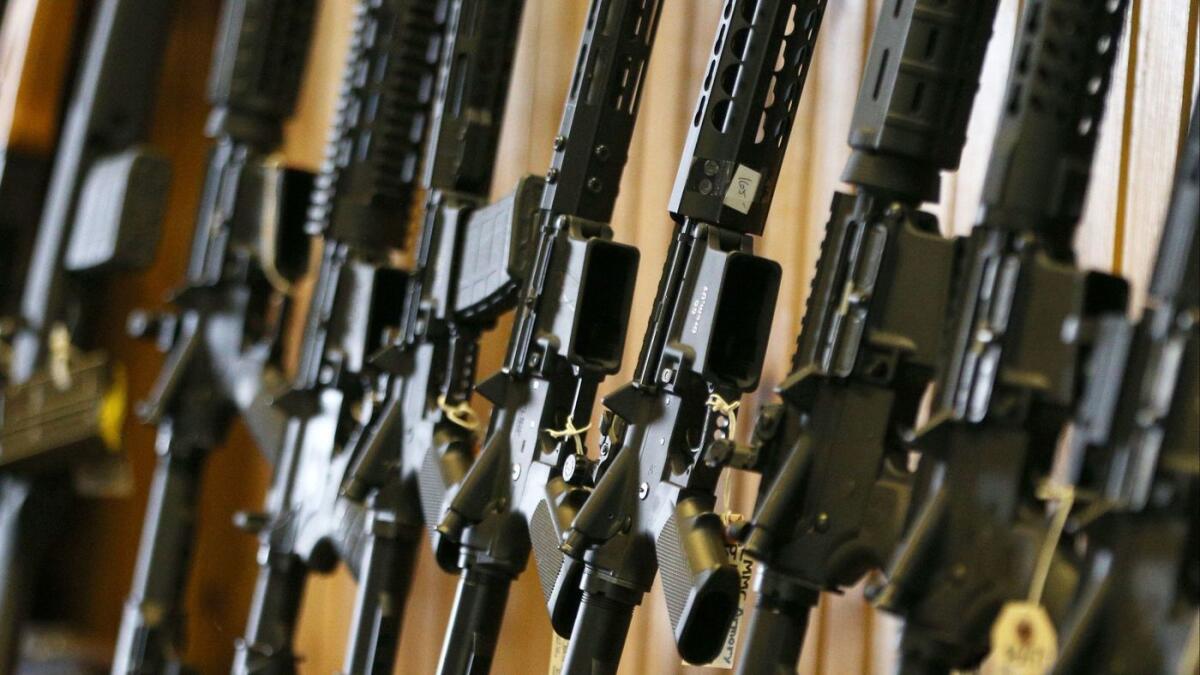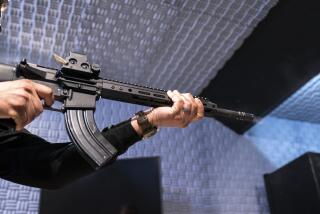Op-Ed: The assault weapons ban didn’t work. A new version won’t, either

- Share via
There is no denying that the AR-15 — an open-source, modular weapon platform that’s the fruit of many tens of billions of private and public dollars in small arms research and almost six decades of innovation — is the most easy to use and the most lethal gun available to civilians. Those of us who defend the 2nd Amendment right to own guns must reckon with this technological reality.
But we can’t find common ground with gun safety advocates as long as they use shoddy arguments and manipulated statistics to cloud the debate. A case in point is the widely cited work of Louis Klarevas, a professor at the University of Massachusetts at Boston whose 2016 book, “Rampage Nation: Security America From Mass Shootings,” has lately bolstered calls for a renewal of the 1994 assault weapons ban, which lapsed in 2004. Sen. Dianne Feinstein (D-Calif.) gave President Trump a bar chart attributed to Klarevas at Wednesday’s guns roundtable.
For the record:
4:50 p.m. March 7, 2018Jon Stokes claims that “virtually all” researchers before Klarevas concluded that it was impossible to discern the assault weapon ban’s effect on mass shooting incidents. Some researchers besides Klarevas concluded otherwise. Stokes also says Klarevas admitted in a footnote that the drop in fatalities from 1994 to 2004 “disappears entirely” if one uses a four-fatality threshold for a “mass shooting” rather than a six-fatality threshold. Stokes could more accurately have said the drop “largely” disappears and Klarevas did not make such an admission. (He was discussing a five-year pause in mass shootings around the same time period.) Finally, Stokes says that Klarevas failed to disaggregate by weapon-type in his list of mass shootings. Klarevas does include a table with that information, but it doesn’t line up perfectly with the two decades in question (the ten years before and during the ban).
Until Klarevas came along, virtually all researchers had concluded that it was impossible to discern what, if any, positive effect the ban’s prohibition of rifles with “military-style features” had on crime or mass shooting incidents. This is why many gun-control advocacy groups, including Sandy Hook Promise, do not include a ban on their list of legislative priorities. The last ban was politically costly for Democrats and, as a ProPublica investigation reported in 2014, gun control experts said there was no evidence it saved lives.
“Rampage Nation” has energized proponents of a new ban by making the spectacular claim that, contrary to the consensus, the original was responsible for a remarkable 37% decline in mass shooting fatalities.
But there’s a serious flaw in Klarevas’ result: There are few actual “assault weapons” of any type in his dataset, either pre- or post-ban. Klarevas and his allies are taking an apparent drop in fatalities from what are mostly handgun shootings (again, pre-ban as well as post) and attributing this lowered body count to the 1994 legislation.
If a new ban passes and it’s anything like the old one, millions of Americans will be able to legally obtain substantially the same guns we can buy today.
I say “apparent” drop in fatalities because, as Klarevas admits in a footnote, if you use the most widely accepted threshold for categorizing a shooting as a “mass shooting” — four fatalities, as opposed to Klarevas’ higher threshold of six — the 1994 to 2004 drop in fatalities disappears entirely. Had Klarevas chosen a “mass shooting” threshold of five fatalities instead of six, then the dramatic pause he notes in mass shootings between 1994 to 1999 would disappear too.
Klarevas doesn’t disaggregate his list of mass shootings by weapon type, so I had to do that myself by cross-referencing his dataset with Mother Jones’ list of U.S. mass shootings and with news reports.
What I found was that for the decade prior to the ban, only two of the 19 mass shootings in Klarevas’ dataset involved civilian versions of military rifles. Another three involved pistols banned by name under the 1994 legislation (two Uzis and one Tec-9), but these small guns use a popular handgun round, 9mm, and not the much larger 5.56 NATO rifle round that features so prominently in current arguments for why the government should ban the AR-15.
As for the decade during which the ban was in place, Klarevas concedes in a footnote that of the 12 shootings in his dataset, only three actually involved assault weapons.
All told, that’s five mass shootings that took place with “assault weapons” in the decade before the ban, and three that took place during its tenure. These numbers are far too small for any sort of statistical inference, especially if you’re trying to build a case for banning tens of millions of legally owned rifles.
Ultimately, the same technological innovations that have made the AR-15 so popular with hobbyists and so lethally effective have also rendered functionally unenforceable the original ban’s feature-based approach. In fact, I can say with confidence, based on the modularity of the AR-15’s design, that if a new ban passes and it’s anything like the old one, millions of Americans will be able to legally obtain substantially the same guns we can buy today, but we’ll just have to buy them in pieces.
The ban’s backers will have once again succeeded in frustrating gun owners with pointless, feel-good regulations, while saving no lives.
Jon Stokes is the co-founder of Ars Technica, a contributing editor to TheFirearmBlog.com and founding editor of AllOutdoor.com
Follow the Opinion section on Twitter @latimesopinion or Facebook
More to Read
A cure for the common opinion
Get thought-provoking perspectives with our weekly newsletter.
You may occasionally receive promotional content from the Los Angeles Times.










